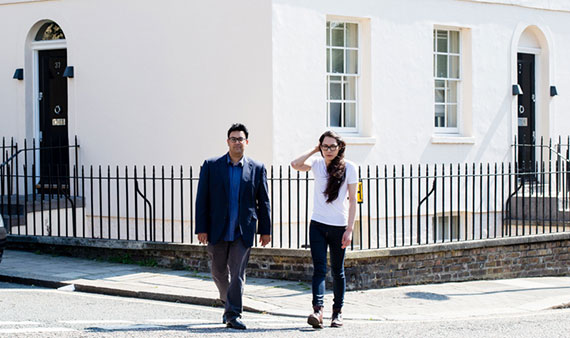
When a mathematical genius and a hedge fund analyst join forces to create a piece of technology, chances are they might be onto something. And when the primary function of that piece of technology is to help the property sector, so much the better.
Introducing Placemake, a revolutionary mapping system that entrepreneurs Chlump Chatkupt and Nikhil Vadgama have been developing since January. A simple idea based on mind-bogglingly complicated software, it is in essence a location analysis tool that will help the real estate sector pick the optimum areas in cities around the world in which to develop, invest and ultimately make the best returns.
This is a system that could not only tell the industry exactly which areas in a city are going to deliver the highest returns, but how much those returns are likely to be and when (and why) they are likely to mature. It can scientifically predict urban and demographic trends. It can automatically identify comparable areas based on stacks of data so comprehensive that it takes the concept of location analysis from instinctive guesswork to mathematical certainty.
The pair are already talking to the biggest players in property, from Lendlease to Land Securities and KMPG to Kajima about the tool. And they are nearly two times oversubscribed for their £750,000 funding round, which is due to close next month, as investors from across the globe scramble to get in on the action.
But there is still one big hurdle to overcome. How do you introduce, implement and market a new system which has been thought up by a pair of minds so great it becomes unfathomably complex to anyone without a PhD in game theory?
Complex idea
In short, it’s tough. While anyone with a tech background might be able to grasp the idea behind the tool – an algorithm that uses data collected from various sources to predict need – it is a different story for the property industry.
“Our system is really different,” says Chatkupt, a London-based New Yorker who actually does have that handy game theory PhD. “Some investors still haven’t quite got it. And those that have don’t tend to be from the real estate world. Because this product is so far off anything anyone in property has ever seen it is actually hard to make sense of the technology. There is no frame of reference.
“For many of them, I suspect this will be quite an education on the power of what tech can do in a sector where it has not been used enough to make decisions yet. For an industry that talks so much about the importance of where you develop and invest, real estate is surprisingly unscientific when it comes to understanding and characterising locations. This tool changes that.”
Placemake’s business model relies on selling subscriptions for between £2,000 and £100,000 a year. Vadgama hints that something around the £30,000 mark is a good starting point for users of the system. And the pair know they have to get people to a point where they understand exactly what the tool is before they commit to that level of investment.
So what is it exactly? Placemake uses machine learning and applies analytics to existing information. Swathes of data and artificial intelligence mean that the tool is able to build up a picture of a certain area by doing a sweep and search of information way beyond the realms of human ability.
And the pair are not just using traditional data such as analysing area searches to gauge popularity and upticks in interest. By also using non-traditional sources including social media posts mentioning certain areas, online check-ins at local bars and restaurants and ATM activity, they can build a comprehensive area snapshot which takes into consideration demographic trends as well as pure statistical data.
For example, if people in a certain postcode are hashtagging coffee and a quick search reveals there are very few coffee outlets in the vicinity, that is high-value market information. Not just because it is revealing, but because it is rare.
The system also uses clustering technology to identify comparable areas. Taking London as an example, if you want to invest in Clerkenwell, EC1, but it is too expensive then a search comparing the data for all areas across the city will reveal that Croydon is a comparable match – just a few years behind, with a greater chance of value uplift.
This information is not based on instinct, common sense or any other intangible form of guesswork, it is based on mathematical algorithms. And it is hard to argue with those.
Demand
Chatkupt and Vadgama are convinced there will be demand for the product. And if it delivers what they say it will then they have every reason to be confident.
“A fundamental issue is this,” says Vadgama. “Right now, if you ask people why they put an asset in a certain place and fill it with the tenants they do, they are ultimately just guessing.
“We extensively interviewed people in the industry for several months from January. I predicted that maybe the residential agents wouldn’t have thought of a tool like ours. But the guys in commercial? I thought ‘they have got to have this stuff already, some kind of technological aid to help make decisions about deploying hundreds of millions of pounds of infrastructure.’ And then we basically found out they don’t. Which was hugely surprising.”
Chatkupt adds: “Things can be done in a much more scientific, methodical way. All of the new tech that machines can process to start giving you real answers that you can then use, combined with your intuition, to make an even better decision.”
Making better decisions
The “making better decisions” line is the ultimate sell. Not just because it makes business sense, but because it addresses a concern that is all too commonly voiced as tech and property continue to collide: is there a danger that will this replace real estate jobs?
“The way that we look at it, this is a tool that will help people who are already in the industry,” says Chatkupt. “This is not about replacing a function. It is about complementing one with additional power.
“We are an enabler. Not a disruptor. We can help people identify areas that real estate developers, agents and investors should be looking at and trends they should be keeping an
eye on so much faster and so much more accurately than anyone can fathom now.”
Whether it’s Rightmove using the system as a plug-in on the residential side to show its customers comparable areas, a mortgage broker using it to see which areas are up and coming, or a real estate investor using it to pick the best location for returns, the pair insist that Placemake has been designed to help, not hinder the sector.
But there is further potential. “We want to help as many people as we possibly can,” says Chatkupt.
“As a society we could use this tool to help understand where public or city services are underrepresented and then target those areas. We could affect housing policy with it. We could help disadvantaged people and we could make global cities smarter and more efficient.”
Next steps
By the end of next month the pair are likely to have raised around £750,000. That investment will go towards hiring the data scientists, machine learning specialists and developers they need to get the system off the ground.
“In the next 12 months we want to have built out the entire infrastructure and back-end architecture,” says Chatkupt.
“Then get the tools into people’s hands and start to see them changing their behaviours and how they make decisions. Then we scale up and we look at New York, Shanghai, Berlin. And it keeps going from there. It is a very scalable system.”
And a lucrative one that the great and good of real estate need to get their heads around if they don’t want to be left behind.
“If you think about why areas are the way they are, it is because their entire make-up is based on what people, humans, thought should be there,” says Chatkupt.
“Data can help you to figure out how an area can better service those people and how we can ultimately create better cities.”












